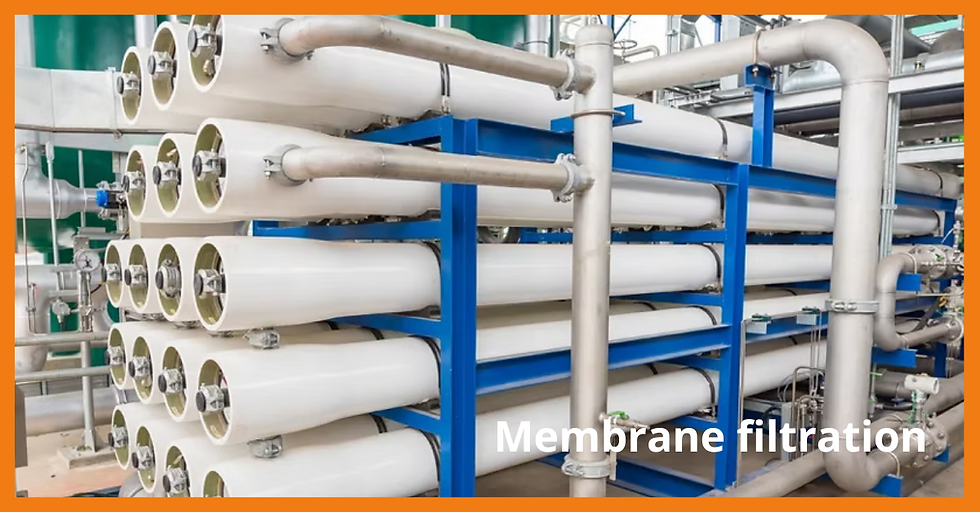Membrane filtration – mastering microbiological purification with BactoSense
- bNovate

- Aug 26
- 3 min read

Filtration systems are commonly used to remove particulate matter from water. In terms of microbiological purification, membrane filtration methods, such as ultrafiltration and reverse osmosis, effectively eliminate bacteria. Meanwhile, media filters, including activated carbon filters, help by removing nutrients that could otherwise promote microbial growth.
As a result, filtration systems play a crucial role in producing clean and safe water.
However, filtration systems are not foolproof. Their effectiveness depends on a complex interaction of factors, including operational conditions, the properties of the feed
water, defects, breaches, biofouling and maintenance.
Continuous monitoring is essential to meet water quality standards at the point of use consistently. Traditional growth-based methods, such as heterotrophic plate count (HPC), must be conducted in a lab, are tedious and take several days.
In contrast, the BactoSense solution provides real-time bacterial monitoring with precise and actionable results in just 20 minutes. In this application note, we outline key application areas and accomplishments reported by BactoSense users in drinking water production, industrial water systems, water reuse and desalination.
BactoSense to increase asset utilisation
BactoSense has been developed to make microbiological data actionable.
Imagine having a tool in your hands to continuously verify the bacterial removal (e.g. log reduction values) of a membrane system, immediately detect filter breaches or declining filtrate quality, swiftly qualify individual assets, and gain a complete understanding of the impact of operational changes on the microbiological quality of the filtrate.
The benefits of BactoSense have been demonstrated across various applications, from monitoring membrane integrity to optimising operational parameters and maintenance practices.
Key application areas and accomplishments reported by BactoSense users include:
Filtrate monitoring
Online bacterial monitoring with measurement intervals as short as 30 minutes enables operators to be immediately alerted if the filtrate quality is abnormal.
Verify the integrity of membrane filtration systems;
Implement an early warning system to detect membrane breaches and gradual membrane performance loss, e.g. due to biofouling or scaling;
Ensure the proper functioning of filtration barriers under all operational conditions, e.g. during maintenance activities or other upstream operations.

Process optimisation
First, understand your process comprehensively, and then improve its performance and resilience.
Optimise timings for filter backwashes and duration of subsequent discharge.
Investigate the effect of operational changes (e.g. flow rate or recovery) on the microbiological filtrate quality.
Understand the kinetics of microbial regrowth during stagnation.
Quantify the filtration efficiency under all relevant operational conditions by measuring feed and filtrate.
Troubleshooting
There is no need to wait days for lab results. Getting results in only 20 minutes speeds up your troubleshooting and helps reduce downtime, whether offline, atline, or online.
After detecting an anomaly in a combined filtrate, directly investigate individual membrane modules.
Swiftly identify poorly performing or defective membranes to mitigate the risk of pathogen passage.
Locate the potential source of contamination, such as membrane failure, regrowth in the feed storage tank, or biofouling of a prefilter.
Asset commissioning, qualification and life cycle management
Things can go wrong during the commissioning of new assets. Implement a monitoring programme to make sure you are in control of microbiology.
Qualify your filtration system: for membrane filtration systems, determine log reduction values by measuring feed and filtrate concentrations online or at-line. Ensure performance requirements are met.
Continuously monitor the filtrate of newly installed membranes to detect “burn-in” failures swiftly.
Feed and filtrate
Better understand the properties of feed and filtrate to optimise filter operation and ensure filter performance requirements are met under all conditions.
Assess the microbiological fluctuations in the feed water to optimise filter operation (e.g., seasonal or operational variations).
Locate microbial contaminations in feed tanks or biofouling in prefilters.
Understand and manage microbial regrowth downstream until reaching the point of use.
Assess the biostability of the water in various steps of the treatment process.

BactoSense is a game-changer for filtration system monitoring and management
The examples above demonstrate that, unlike traditional methods, Bactosense empowers operators to detect membrane issues early, optimise performance, and swiftly address potential risks.
Book a demo today to explore how BactoSense revolutionises how water quality is managed in processes such as drinking water production, desalination and water reuse by providing continuous, actionable insights.










Comments